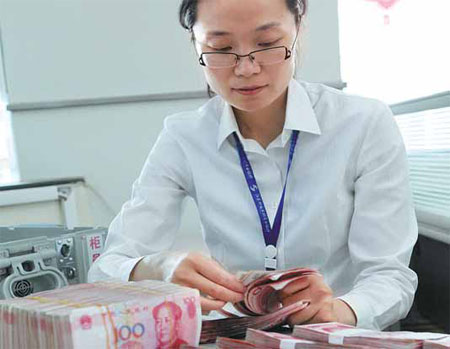FX purchases decline on signs of US QE easing
|
The amount of yuan used for foreign exchange purchases by financial institutions, an indicator of capital flows, declined to 27.39 trillion yuan last month, the first drop in seven months, the central bank said. Si Wei / for China Daily |
China reported the first decline of foreign exchange purchases in seven months amid signs the United States will "taper off" its quantitative easing policy.
Foreign exchange purchases by financial institutions, a major indictor of capital inflows or outflows, fell 41 billion yuan ($6.6 billion) to 27.39 trillion yuan last month, according to data released by the People's Bank of China, the central bank, on Monday.
The decline came against the backdrop of a high trade surplus of $27 billion and strong foreign direct investment inflows of $14 billion during the same month.
The data show that China experienced strong capital outflows in June, a sharp reversal from early 2013, said Zhang Zhiwei, chief China economist at Nomura Holdings Inc.
From January to April, foreign exchange purchases rose by an average of 377 billion yuan each month, according to central bank statistics.
In May, they rose by 66 billion yuan, as growth concerns emerged and the government started to crack down on illegal capital flows.
The State Administration of Foreign Exchange said on Monday in a statement that the net capital inflows that China experienced in previous months moderated "substantially" amid US signs on QE and downside pressure on China's economy.
Meanwhile, it said, "expectations of appreciation of the yuan have eased. Yuan forwards even imply broader depreciation against the dollar".
It said tightened regulation in recent months of cross-border trade settlements and capital flows have "caged" arbitrage money flows disguised as trade deals, which also led to the moderation of capital inflows.
"There is no sign of a collective withdrawal of foreign investment."
Zhang said: "The capital outflows in June reinforce our view that the central bank will cut the reserve requirement ratio by 50 basis points in each quarter from the third quarter of 2013 to the second quarter of 2014."
He said China will experience a prolonged period of capital outflows in the second half of this year and the first half of 2014 as growth slows and investors worry about a potential hard landing in China.
"The PBOC will need to cut the reserve ratio to offset the negative effects from capital outflows on domestic liquidity conditions."
The capital outflows signaled that the central band's liquidity management is facing new challenges, said Guang Qing-you, an analyst at Minsheng Securities Co Ltd.
China just experienced the worst liquidity crunch in a decade as interbank interest rates surged last month to the highest levels since 2003.
In a recent statement, the PBOC said it will keep the money market stable with a combination of tools, including open market operations, re-lending, rediscounting, short-term liquidity operations and standing lending facilities.
SAFE said fluctuation of cross-border capital flows in both directions would be more frequent in the future. "In the second half, we expect the flows would become more balanced by going through some fluctuations."
Zhao Qingming, a professor at the University of International Business and Economics, said the drop in foreign exchange purchases isn't a big deal, because China experienced a seven-month decline in the purchases between 2011 and 2012.



















